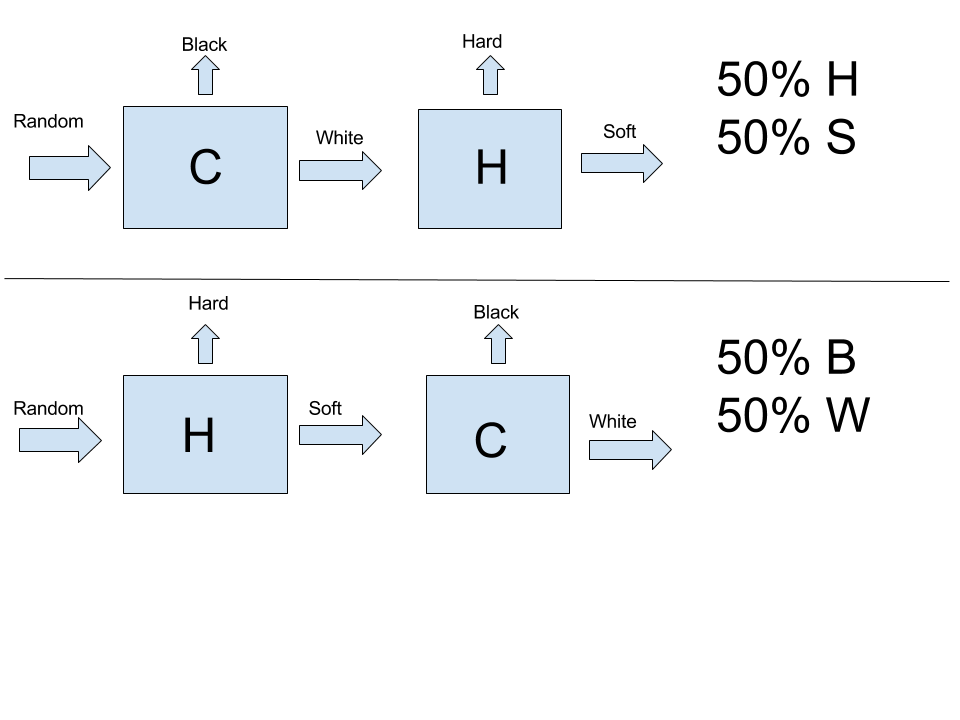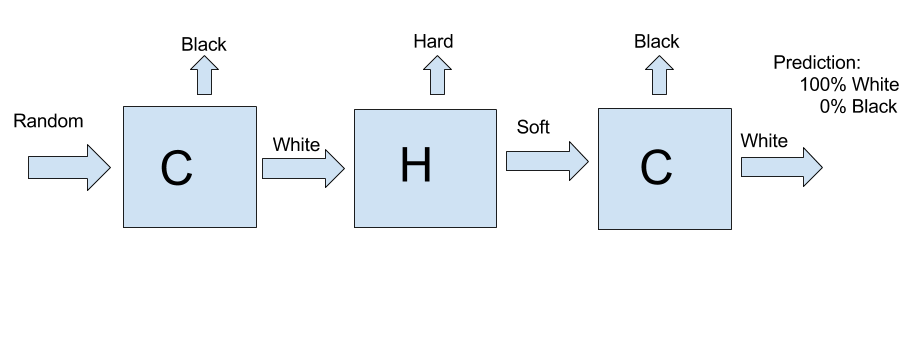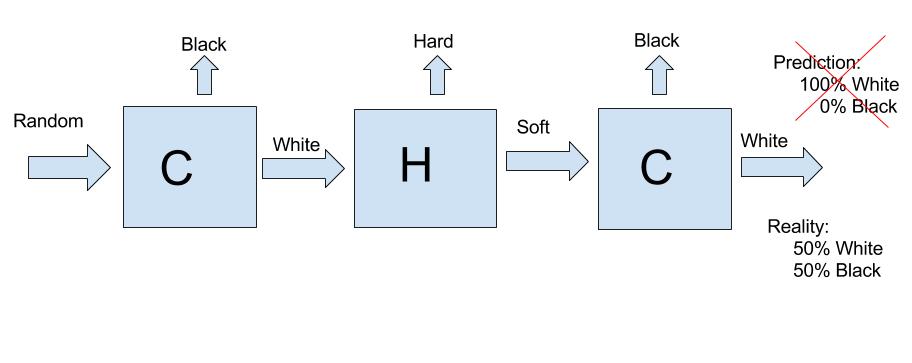Quantum Mechanics - Common Sense
Quantum Mechanics is the most accurate theory to describe the microscopic world. It is also a relatively new field in physics less than 100 years starting around 1928. Often people find the concepts presented in quantum mechanics to be bizzare but really they are not as bizzare as they may seem. In fact quantum mechanics is very much sensiable just not your every day "common sense". Since we are so adepted to the macroscopic world and we have evolved our senses to the macroscopic world we have been led to believe certain things which actually don't apply in the microscopic world. The idea of
Lets consider the following we have two different boxes. One detects the color of the particle sent and if it is black it'll be thrown upwards if not it'll continue to the right. Same thing with the other box expect it detects if the particle is soft or hard. While these aren't really properties of an actual particle you can pertend that color represents the x axis momentum or the hardness is the y axis momentum but either way its just easier to use colors and hardness since those are what people are familiar with. So the following detectors will look something like below.

So a question that can be posed is does knowing the color effect the hardness? Well we can test it with an experiment to determine if there is any correlation by setting up our boxes like the following. We send a random particle into a color box and than whatever is white will go into the hardness box and we'll get a result of which percentage of the particles at the end are hard or soft. If there is no relationship than we'll see a 50-50 distribution. We do two of these experiments one with the color detector first and the other with the hardness detector first. If there is truely no relation it makes "common sense" that it'll be 50-50 like flipping a coin.  So using common sense so far since for both no matter how we arrange them the result is 50-50 which makes sense since hardness and color have nothing to do with each other. In fact it is a 50-50 distribution meaning no correlation or relationship between the hardness and the color for a particle. This is concluded through the experiment and thus knowing the color doesnt tell you anything about the hardness and vice versa.
So using common sense so far since for both no matter how we arrange them the result is 50-50 which makes sense since hardness and color have nothing to do with each other. In fact it is a 50-50 distribution meaning no correlation or relationship between the hardness and the color for a particle. This is concluded through the experiment and thus knowing the color doesnt tell you anything about the hardness and vice versa.
Now lets look at another simple experiment using these boxes. So now lets say we have random particles going into a color detector and all the white particles go into the hardness box and all the soft particles out of the hardness detector go into another color box. So now since originally we sent in white particles into our hardness box so our predication is that at the end 100% of the particles are white.  So it makes sense to predict that 100 percent of the particles will come out at the end of the experiment to be white since initially all the particles sent to the hardness box is white. However that is wrong! What actually happens is that 50 percent of them is white and 50 percent is black!
So it makes sense to predict that 100 percent of the particles will come out at the end of the experiment to be white since initially all the particles sent to the hardness box is white. However that is wrong! What actually happens is that 50 percent of them is white and 50 percent is black!
 So what is going on here? Well one of the first natural assumptions to make here is that these boxes are not working properly. Well that isn't the cause because many experiments have been done with different kinds of technologies and this still holds true so that argument can not be made. Another thing you can say is that there is some hidden variable that we do not know of that can determine the end result of the particle. This is also not true since many scientists have tried to observe the particles for these properties that can tell them the end result but none was found. So the only thing we are left with is that we are forced into the idea that a particle's properties are not something that is permanent at least not in the classical sense. Even if we changed the boxes around to have the hardness box first sending only soft particles its still the same case.
So what is going on here? Well one of the first natural assumptions to make here is that these boxes are not working properly. Well that isn't the cause because many experiments have been done with different kinds of technologies and this still holds true so that argument can not be made. Another thing you can say is that there is some hidden variable that we do not know of that can determine the end result of the particle. This is also not true since many scientists have tried to observe the particles for these properties that can tell them the end result but none was found. So the only thing we are left with is that we are forced into the idea that a particle's properties are not something that is permanent at least not in the classical sense. Even if we changed the boxes around to have the hardness box first sending only soft particles its still the same case.  This is only the tip of the iceburg when it comes to the weirdness of quantum mechanics.
This is only the tip of the iceburg when it comes to the weirdness of quantum mechanics.